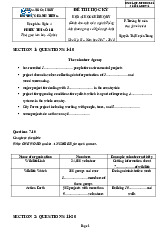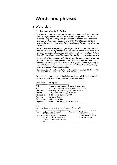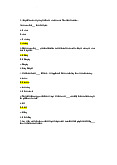

















Preview text:
TRƯỜNG ĐẠI HỌC KINH TẾ KỸ THUẬT CÔNG NGHIỆP KHOA NGOẠI NGỮ -------o0o------- BÀI TẬP LỚN
“Phân tích đối chiếu Phụ âm tiếng Anh và tiếng Việt”
Họ và tên sinh viên:Lại Thị Phương Anh Lớp: DHNN14A3HN Mã sinh viên: 20109100013
GVHD: T.S Hoàng Thị Minh Lý
HÀ NỘI, THÁNG 12-2022 1 lOMoAR cPSD| 40190299
UNIVERSITY OF ECONOMICS – TECHNOLOGY FOR
INDUSTRIES FACULTY OF FOREIGN LANGUAGES -------o0o------- FINAL ASSIGNMENT
“Consonants in English and Vietnamese:
A contrastive Analysis”
Student’s name: Lai Thi Phuong Anh Class: DHNN14A3HN Student’s code: 20109100013
Instructor: M.A Hoang Thi Minh Ly Hanoi, 12-2022 2 lOMoAR cPSD| 40190299 TABLE OF CONTENTS INTRODUCTION 4 1. Rationale of the study 4 2. Aims of the study 4 3. Design of the study 5 DEVELOPMENT 5 1. English consonants 5 1.1.Place of articulation 6 7 1.2.Manner of Articulation 8 1.3. Voicing 2.Vietnamese consonants 9 2.1.Place of articulation 10 2.2.Manner of Articulation 10
3. Contrasted analysis between English and Vietnamese 13 3.1. Similarities 13 3.2. Differences 16 17 CONCLUSION 19 REFERENCES INTRODUCTION 3 lOMoAR cPSD| 40190299 1. Rationale
Speaking English like truly native speakers is the dream of the English learners.
However, there are many pronunciation problems the English leamers faced such as
consonants, vowels, stress..etc... Vietnamese learning English also make the same
mistakes bause of some differences and similarities in pronouncing consonants
between English and Vietnamese. During English learning at HPU, I myself have
encountered great difficulties in learning English pronunciation especially consonants
pronunciation. If we can understand and practice consonants pronunciation clearly,
judiciously, the English pronunciation problems will be overcome and improved. The
above reasons have inspired me to carry out the study with the title "A contrastive
analysis of consonants in English and Vietnamese". les tea team Aims of the study 2. Aims of the study
With the hope of getting a more comprehensive and specific understanding of English
consonants, finding out common consonants pronunciation mistakes faced by
Vietnamese, and giving some techniques to improve English consonants pronunciation
to Vietnamese, my study focused on: Introducing the basic theories of English and
Vietnamese consonant and their differences and similarities. Particularly, giving the
principles of consonant pronunciation and raising the learner’s awareness of English
pronunciation by giving specific evidence, examples, figures, and pictures may make
learners try to pronounce like native speakers. Providing some exercises may be very
helpful for learners in English pronunciation as well as in English communication 4 lOMoAR cPSD| 40190299 today 3. Design of the study
This paper provides a clear organization consisting of 3 main parts that help an
exploration and practical benefit gained for readers as well
Part I: The introduction includes the rationale of the study, aims of the study, and design of the study.
Part II: Overview analysis of consonants in English and Vietnamese Part III: Conclusion DEVELOPMENT 1. English consonants
There are 24 consonants in English. They are classified according to 3 aspects:
voicing, place of articulation and manner of articulation. Table 1: English consonants Manner of Place of articulation articulatio
Bilabia Labiodental Denta Alveola Palato- Palatal Velar Glotta n l l r alveolar l Plosive p b t d k g Fricative f v θ ð s z ∫ ʒ h 5 lOMoAR cPSD| 40190299 Affricate tʃ dʒ Nasal m n ŋ Lateral l Approxima w r j nt (Peter Roach p 62)
1.1.Place of articulation
Here I take most of the definitions from Oxford Advanced Leaner’s Dictionary.
- Bilabials are consonants that are produced by using the two lips. English has 4
bilabial consonants. They are /p, b, m, w/.
- Labiodentals are consonants that are produced by “placing the top teeth against the
bottom lip”. There are 2 labiodental sounds in English. They are /f, v/.
- Dentals are consonants that are articulated by placing the tongue between the teeth.
English dental sounds include /, ð/.
- Alveolars are consonants that are produced “with the tongue touching the part of the
mouth behind the upper front teeth”. There are 7 alveolar sounds in English. They are /t, d, s, z, n, l, r/.
- Palato-alveolars are consonants that “are produced by the contact of the front part of
the tongue with the hard palate just behind the alveolar “ridge” according to the 6 lOMoAR cPSD| 40190299
definition of palate-alveolar on the website http://www.unikassel.de. English palato-
alveolars include 4 consonants /ʃ, ʒ, tʃ, dʒ/.
- Palatals are consonants produced by “raising the tongue body against the hard
palate”. There is only 1 palatal sound. That is /j/.
- Velar are consonants made by “placing the back part of the tongue near or against the
back part of the mouth -the soft palate”. There are 3 velar sounds. They are /k, g, ŋ /.
- Glottal is consonants articulated with the glottis. There is only 1 glottal sound in English. That is /h/.
1.2.Manner of Articulation
- Plosive consonants are consonants made by “completely stopping the flow of air
coming out of the mouth and then suddenly releasing it” (OALD). There are six plosive
consonants in English. They are /p, b, t, d, k, g/.
- Fricative consonants are consonants articulated by forcing air through a “narrow
space in the mouth with the lips, teeth or tongue in a particular position” (OALD).
English fricatives include 9 consonants. They are /f, v, θ, ð, s, z, ∫, ʒ, h/.
- Affricates are consonants made up of a plosive followed immediately by a fricative
(OALD). There are 2 affricate consonants. They are / tʃ, dʒ /.
Nasal are consonants produced by “allowing the air to escape freely through the nose”
(OALD). There are 3 nasal sounds. They are /m, n, ŋ
- Lateral are consonants “produced by placing a part of the tongue against the palate so 7 lOMoAR cPSD| 40190299
that air flows around on both sides of the tongue” (OALD). There is only one lateral
sound in English. That is /l/.
- Approximants are consonants made by bringing the parts of the mouth which produce
speech close together but not actually touching (OALD). There are 3 approximant consonants /w, j, r/. 1.3. Voicing
Voicing also plays an important part in distinguishing sounds. The voiced consonants
are those that are produced with the vibration of the vocal cord and the voiceless
consonants are sounds pronounced without the vibration of the vocal cord. Voiceless
consonants include /p, t, k, f, θ, s, ∫, h, tʃ/.
Voiced consonants: /b, d, g, v, ð, z, ʒ, dʒ, m, n, l, w, r, j/. Table 2 : English consonants
Ordinal Phonemes Letters Examples
Ordinal Phonemes Letters Examples 01 p p pea, pin 13 b b bee, been 02 t t toe, tea 14 d d do, does 03 k c cap, car 15 g g gap, go 04 f f fat, fan 16 v v vat 05 θ th thing thank 17 ð th this, that 8 lOMoAR cPSD| 40190299 06 s s sip, sea 18 z z zip 07 ∫ sh ship, shape 19 ʒ measure 08 h h hat, hear 20 l l led 09 m m map, man 21 r r red 10 n n now, nap 22 j y yet 11 ng hang, hung 23 w w wet was 12 tʃ ch chin, 24 dʒ g gin Chinese
2. Vietnamese consonants
Vietnamese has 22 initial consonants and 8 final consonants. They are also classified
according to place of articulation, manner of articulation and voicing.
Table 3: Vietnamese initial sounds Place of articulation Manner of articulation Labial
Alveola Retrofle Palata Vela Glotta x r l r l Stop Aspirate t’ d un- voiceless t ʈ c k ʔ aspirate d voiced b d 9 lOMoAR cPSD| 40190299 nasal m n ɲ ŋ fricativ voiceless f s ş x h e voiced v z ʐ ɣ lateral l
1.1.Place of articulation
- Labial: Vietnamese has 5 labial consonants. They are /b, m, f, v/.
- Alveolar: There are 7 alveolar consonants in Vietnamese. They are /t’, t, d, n, s, z, l/.
- Retroflex: Retroflex consonants includes 3 sounds /ʈ, ş, ʐ/.
- Palatal: There are 2 palatal sounds in Vietnamese. They are /c, ɲ/
- Velar: Vietnamese velar consonants consist of 4 sounds. They are /k, ŋ, x,
ɣ/ -Glottal: There are 2 glottal consonants in Vietnamese. They are /ʔ, h/
1.2.Manner of articulation
-Vietnamese consonants are divided into two kinds in term of manner of
articulation. Stop consonants include 12 sounds. They are /b, t’, t, d, ʈ, c, k, ʔ, m, n,
ɲ, ŋ/ Fricative consonants include 10 sounds. They are /f, v, s, ş, ʐ, z, ɣ, h, l/ -The stops
There are also different kinds of stop consonants in Vietnamese
Aspirated stop consonant includes /t’/.
Voiceless unaspirated stop consonants include /t, ʈ, c, k, ʔ/. 10 lOMoAR cPSD| 40190299
Voiced unaspirated stop consonants include /b, d, ɲ,ŋ/.
Nasal stop consonants include /m, n/. The fricative
Voiceless fricative consonants include /f, s, ş, x, h/.
Voiced fricative consonants include /v, z, ʐ, ɣ/.
Lateral fricative consonant includes /l/.
Table 4: Vietnamese initial sounds Stt Âm Con chữ Ví dụ Stt Âm Con chữ Ví dụ 01 b b ba, bàn 12 ʈ tr trâu, trắng 02 m m mạ, mang 13 ş s sâu sắc 03 f ph phao, pha 14 ʐ r ráo riết 04 v v vào, việt 15 c ch chào chú 05 t’ th thầy, tha 16 ɲ nh nhà nho 06 t t tay, ta 17 k c, k, q co, quà, kẹo 07 d đ đi, đứng 18 ŋ ng, n, gh ngày, nghèo 08 n n nao, núng 19 x kh khó khăn 09 s x xanh, cây 20 ɣ g,gh gà, ghê 10 z d, gi dày, gian 21 ʔ (khuyết) 11 l l lo lắng 22 h h hay, ho 11 lOMoAR cPSD| 40190299
Table 5: Vietnamese final consonants Manner of articulation Place of articulation Labial Alveolar Velar Noise consonant p t k Sonant nasal m n ŋ semi -consonant -w -j Place of articulation
- Labial sounds include /p, m, -w/.
- Alveolar sounds include /t, n,-j/.
- Velar sounds include /k, ŋ, - j/. Manner of articulation
Vietnamese final consonants are also classified in terms of place of articulation and manner of articulation.
- Noise consonant sounds include /p, t, k/.
- Sonant sounds include 3 nasal consonants /m, n, ŋ/ and 2 semi- consonant sounds /-w, -j/.
Table 6: Final consonants in Vietnamese Stt Âm Con chữ Ghi chú Ví dụ 01 -p p mọi trường hợp Tập, phép, úp, giúp 12 lOMoAR cPSD| 40190299 02 -t t mọi trường hợp bát, bút, nét, cát 03 -k ch
Sau nguyên âm bổng i, , e Chênh, cháp, lịch, địch c
trong các trường hợp khác khác, cóc, gấc 04 -m m mọi trường hợp thêm, làm, nhầm, móm 05 -n n mọi trường hợp nhân dân, sán, bạn 06 -ɲ nh sau âm bổng i, , e lệnh, nhanh, bánh ,thánh -ŋ ng
trong các trường hợp khác phông, mang, tháng , đường 07 -w o sau nguyên âm đơn dài báo, tạo, phao, bạo u trong trường hợp khác cau, trầu, xỉu, trâu 08 -j y sau nguyên âm ngắn , ă máy, bay, này, mày
After analyzing the two consonant systems, I withdraw some similarities and
differences between the two languages. 3. Contrasted analysis
3.1. Similarities
- They all use the phonological modes and the position of the sound with the same
criteria to classify consonants. Example:
- Phonological modes: plosive, fricative, nasal
- Position of pronunciation: lips, tongue
- The number of consonants is relatively similar Example: /p/, /b/, /m/, /n/
- Most of the consonants in the two languages are the same as the written
word. Example: In Vietnamese: b, m, v, t n, l, h
- In English: p, t, f, s, h, m, b, g, v, l, r, w
In the initial sound system, Vietnamese and English both have these consonant 13 lOMoAR cPSD| 40190299
sounds /b, d, k, m, n, f, v, s, z, h, l/. b (bàn or bird) d (đu or duck) k (kéo or kite) m (mẹ or mom) n (non or nut) f(phố or fish) v(về or visit) s(xong or seat) z(giỏ or zebra) h(hộp or head) l(lớn or lemon)
In the final sound system, the two languages have these consonant sounds in common. p (khắp or sharp) t(bút or meat) k(lúc or duck) m(xem or mom) n(xin or burn) ŋ(phông or sing)
It would be better that we pay attention to these final sounds /p, t, k/ which are held in 14 lOMoAR cPSD| 40190299
Vietnamese but released in English. 3.2. Differences
- There are similarities between Vietnamese and English, but there are also differences.
3.2.1. Pronunciation method (For plosive) -In Vietnamese: + Aspirated plosive: /t’/
Example: Thảnh thơi, thỉnh thoảng, tha thiết,...
+ Plosive, unaspirated, voiceless: /t/,/k/,/c/,/th/
Example: tung tăng, kiểm kê, chim chóc.
+ Plosive, unaspirated, voiced:
/b/,/d/ Example: bạn bè, bay bổng
+ Plosive, nasal: :/m/,/n/,/ ŋ/
Example: Mẹ, nũng nịu, minh mẫn, nhung nhớ, nghiêng nghiêng, nghe ngóng, nghĩ ngợi. - In English: Both plosive and affricative:
+Plosive: /p/, /b/, /t/, /d/, /k/, /g/,...
Example: Happy, postcard, beer, body, birthday, tea, pretty, tennis, key, kind, milk, together, glass,... +Affricative: /dʒ/, /tʃ/
Example: Large, jam, church, cherry, chip, watch, choose, lunch,..
1.2.2. The position of consonants in syllables
- There are certain parallels between Vietnamese and English, such as the fact that the
starting and ending sounds in Vietnamese are the same as those in English, however: - In English:
+ English consonants can appear at any point along a syllable—beginning, middle, or end.
Example: s (sea - was), r (rose - her), d (drink - good), k (kind - breakfast), w (with -
yellow), n (national - chicken), l (like – beautiful).
=> Clarify the difference between strong and weak consonants. - In Vietnamese:
+ Consonants at the beginning of syllables include: b, th, ph, v, đ, d, g, l, tr, q, k, s, r, kh, h, x, p, m, n,...
Example: Bảo đảm, thương yêu, xuất phát, di tích, hàng hóa, việc làm, lao động, chiến
sĩ, phương pháp, giáo dục, rảnh rỗi, khúc khích,...
+ In Vietnamese, there are consonants at the end of syllables include: -p, -t, -ch, -c,-m, -n, -nh, -ng...
Example: nhường nhịn, chúc tụng, anh em, trấn an, lớp học, hớt hải...
+ In addition, there are some missing consonants in Vietnamese
Example: an ủi, ăn uống, uyên ương, âm ỉ, ào ạt, ồn ào, ầm ầm 15 lOMoAR cPSD| 40190299 c. XL1 ФXL2
(Trong đó X: yếu tố ngôn ngữ, L1: Ngôn ngữ tiếng Việt, L2: ngôn
ngữ Tiếng Anh) cái phần trong ngoặc này mày cho vào cái bảng viết tắt í -In fricative sound:
+In Vietnamese, there are not /dʒ/, /tʃ/, /θ/, /ð/, /ʒ/ (they are just in English)
+In English, there are not [x, γ, Ş, tr, nh, kh, ng]. (they are just in Vietnamese) -In nasal sound:
+There are not /ɲ/ in English
+If English has consonants [k, g] they are called velar- plosive, in Vietnamese
consonant [k] is called “tắc gốc lưỡi” and /ɣ/ is call “ xát gốc lưỡi” Example: In
English /g/: “given, gold, gate, girl, get”.
+In Vietnamese /ɣ/: “ghế, ghi, ghép, gom góp”.
+ In English there are also consonants which don’t have in Vietnamese: [w], [j] CONCLUSION
In conclusion, through a contrastive view into English and Vietnamese
consonants, I would like to discuss some implication for teaching and learning at the high school in our country.
Firstly it is necessary for teachers to help students to understand how to
pronounce difficult consonant sounds in English. Teachers should explain clearly to
their students about the features of consonants based on voicing, place of articulation and manner of articulation.
Secondly, learners should be given more chances to practice pronunciation in
and outside classrooms because practicing will make their pronunciation more
accurately and naturally. Now, there are a lot of ways for students to practise
pronunciation. A lot of books together with audio files such as Ship or Sheep, Tree or
Three offer many exercises for students to improve their pronunciation. Besides that, 16 lOMoAR cPSD| 40190299
internet is also a useful tool for learning pronunciation.
Thirdly, teachers should spend time correcting students’ mispronunciation
frequently so that students can realize their problems and pay more attention to the
sounds that they often spell wrongly.
Last but not least, students should be encouraged to talk to native speakers so
that they are familiar with the real pronunciation outside the classrooms.
Though becoming fluent in English may take a long time, I believe that if students try
their best to practise, gradually they can improve the ability to speak and communicate in English. 17 lOMoAR cPSD| 40190299 REFERENCES
Duong Thi Nu.(2009) Mistake or Vietnamese English. Hanoi. Vietnam National University
Đoàn Thiện Thuật.(1957). Ngữ âm tiếng Việt. Hanoi. Hanoi National University Publisher.
Hoang Thi Quynh Hoa (1965). A Phonological Contrastive Study of Vietnam and
English. Texas. Texas Technological College.
Le Quang Thiem.(2004).Ngôn ngữ học đối chiếu. Hanoi: Hanoi National Unniversity Publisher.
Oxford Advanced Learner’s Dictionary.(2007).Oxford. Oxford University Press.
Palato-alveolars. Dec 20, 2009, from http://www.unikassel.de/.
Peter Roach.(1991).English phonetics and phonology. Cambridge: Cambridge University Press.




